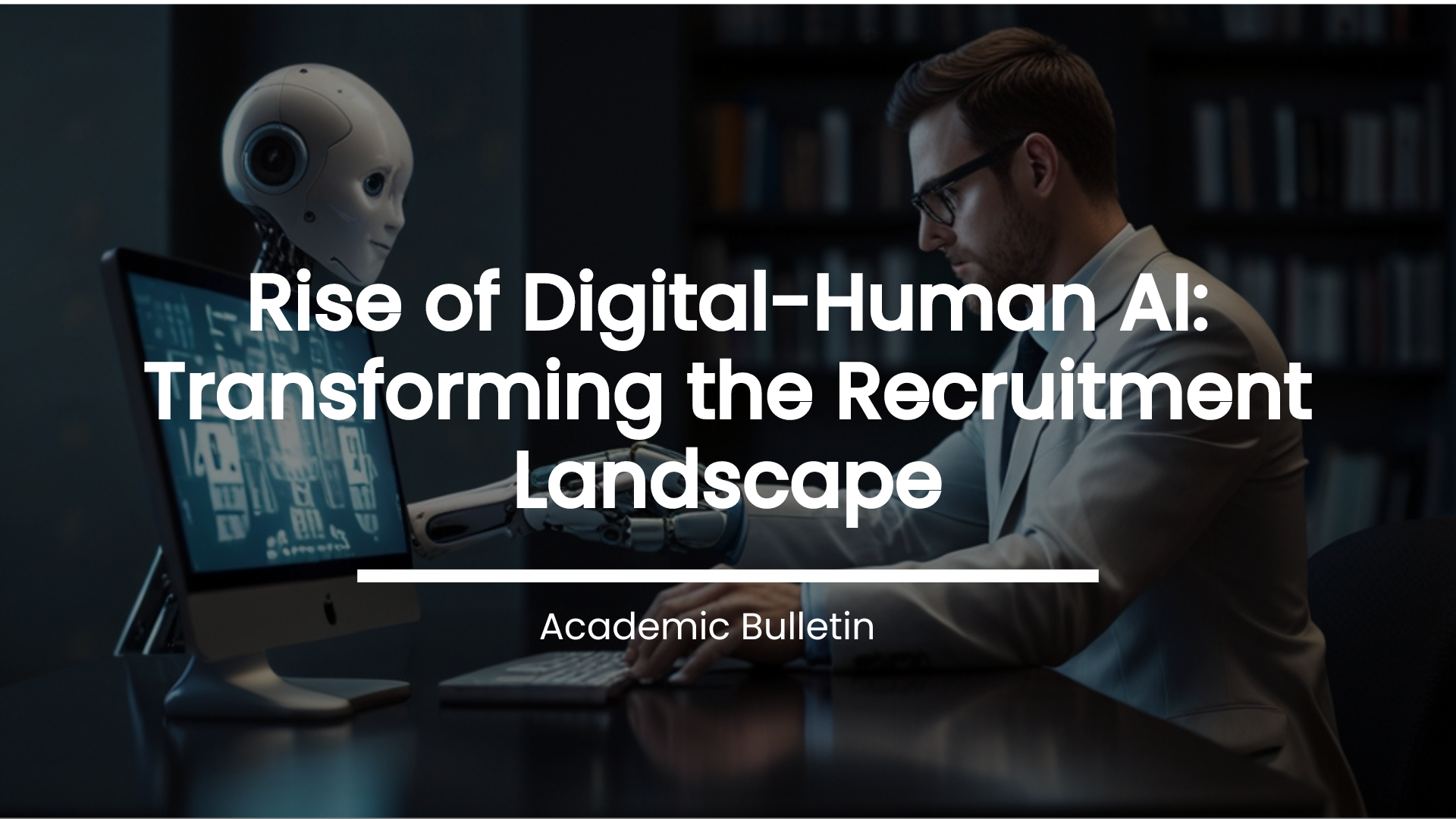The recruitment industry, long reliant on traditional methods like resumes and interviews, is undergoing a significant transformation with the integration of Artificial Intelligence (AI). One of the most captivating advancements in this realm is the rise of digital-human AI, also known as conversational AI or virtual recruiters.
What is Digital-Human AI?
Digital-human AI is a sophisticated technology that utilizes artificial intelligence and computer graphics to create lifelike, virtual characters that can interact with humans in a natural and engaging way. These AI-powered avatars can hold conversations, answer questions, and even conduct interviews – blurring the lines between human and machine interaction.
A Look Back: The Evolution of AI in Recruitment
The use of AI in recruitment isn’t entirely new. Previously, AI primarily focused on automating repetitive tasks like resume screening and candidate filtering. However, digital-human AI takes this a step further by introducing a more human-centric approach to the recruitment process.
How Does Digital-Human AI Work?
Here’s a breakdown of the key components involved:
- Natural Language Processing (NLP): This technology allows the digital human to understand the meaning and intent behind a candidate’s spoken or typed words, enabling natural conversation.
- Machine Learning: The AI learns and improves over time through continuous interaction with candidates. This allows the digital human to tailor its responses and provide a more personalized experience.
- Speech Recognition and Synthesis: These technologies enable the digital human to understand and respond to spoken communication in a realistic manner.
- 3D Character Animation: This creates the lifelike appearance of the digital human, enhancing the overall user experience.
The Digital-Human AI Industry: Landscape and Major Players
The digital-human AI industry is still relatively young, but it’s witnessing rapid growth. Here’s a glimpse into the current landscape and some of the major players:
- Market Size and Growth: According to a report by Grand View Research [1], the global conversational AI market size was valued at USD 8.4 billion in 2022 and is projected to reach USD 43.9 billion by 2030, growing at a Compound Annual Growth Rate (CAGR) of 23.2% from 2023 to 2030. This significant growth indicates the increasing adoption of AI-powered solutions across various industries, including recruitment.
- Major Players: Some of the leading companies developing and offering digital-human AI solutions for recruitment include:
- IIMjobs (India): This Indian startup offers a digital interview platform powered by AI-powered avatars that can conduct initial screening interviews in multiple languages.
- Paradox (US): This US-based company provides a virtual interview platform featuring customizable digital interviewers that can assess candidates through a combination of pre-recorded video questions and live interaction.
- Mya (US): Mya offers a suite of AI-powered solutions for recruitment, including a virtual interview assistant that can handle initial screening interviews and schedule follow-up interviews.
- Tencent (China): The Chinese tech giant Tencent has also developed its own digital-human AI platform called “WeCa Zhihui,” which can be used for various HR functions, including recruitment interviews.
Specifications of Digital-Human AI Solutions
Digital-human AI solutions can vary in their functionalities and specifications. However, some common features include:
- Multilingual capabilities: Some digital humans can converse in multiple languages, catering to a global talent pool.
- Question customization: Recruiters can customize the interview questions asked by the digital human to align with specific job requirements.
- Non-verbal communication: Advanced digital humans might be able to analyze a candidate’s facial expressions and body language to gain further insights.
- Data analysis and reporting: The platform might generate reports that analyze candidate responses and performance during the interview.
Critical Analysis: A Balanced Perspective
Digital-human AI offers significant benefits to the recruitment process, but it’s crucial to acknowledge potential drawbacks:
Benefits:
- Efficiency and Speed: Digital humans can conduct initial interviews 24/7, significantly accelerating the initial candidate screening process. A 2023 study by Gartner predicted that by 2023, 70% of organizations would have adopted some form of conversational AI, highlighting the growing adoption rate and potential for efficiency gains.
- Reduced Bias: By automating the initial screening process, digital humans can mitigate subconscious human biases that might creep into traditional resume screening.
- Improved Candidate Experience: Digital humans can provide a more engaging and interactive interview experience, especially for tech-savvy candidates. A 2022 study by PwC found that 72% of job seekers believe AI can improve the overall candidate experience during the recruitment process.
- Global Reach: Digital human AI can overcome geographical barriers, allowing companies to tap into a wider pool of talent across the globe.
Potential Drawbacks:
- Lack of Empathy: While digital humans can mimic human conversation, they might not be able to replicate the emotional intelligence and empathy of a human interviewer.
- Ethical Concerns: The use of AI in recruitment raises ethical concerns around data privacy and the potential for manipulation during the interview process.
- Technological Limitations: The technology is still under development, and digital humans might not be able to handle complex or nuanced questions effectively.
- Job Displacement: While some argue that digital humans will create new job opportunities, there’s also a concern that they might displace human recruiters in certain roles.
The Future of Digital-Human AI in Recruitment
Despite the potential drawbacks, the future of digital-human AI in recruitment appears promising. Here are some predictions for the coming years:
- Increased Adoption: As the technology matures and costs decrease, we can expect wider adoption of digital human AI across various industries.
- Enhanced Capabilities: Digital humans will become more sophisticated, capable of handling complex conversations and assessments.
- Seamless Integration: Digital AI will seamlessly integrate with existing HR systems, creating a more streamlined and efficient recruitment workflow.
- Focus on Human-AI Collaboration: The future lies in a collaborative approach, where AI handles the initial screening and data analysis, while human recruiters focus on building rapport with shortlisted candidates.
Conclusion
Digital-human AI is revolutionizing the recruitment landscape by offering increased efficiency, reduced bias, and a more engaging candidate experience. However, it’s crucial to address ethical concerns and ensure the technology complements, rather than replaces, human interaction in the recruitment process. As the technology evolves and integrates more seamlessly with existing systems, digital-human AI has the potential to transform the recruitment industry in several ways:
- Data-Driven Decision Making: Digital humans can gather and analyze vast amounts of candidate data during the interview process. This data can provide recruiters with deeper insights into candidate skills, personality traits, and suitability for the role, facilitating data-driven decision making.
- Personalized Candidate Journeys: The technology can personalize the candidate journey by tailoring interview questions and follow-up communication based on the candidate’s profile and performance.
- Employer Branding Boost: Utilizing digital-human AI can project a forward-thinking and innovative image for companies, potentially attracting a wider pool of top talent.
In Conclusion
The rise of digital-human AI marks a significant shift in the recruitment landscape. By embracing this technology strategically, companies can achieve greater efficiency, reduce bias, and improve the candidate experience. However, it’s vital to address ethical concerns, ensure human oversight, and equip the workforce with the necessary skills to navigate this evolving environment. As AI and human interaction converge in the recruitment process, the future promises a more dynamic and data-driven approach to talent acquisition.


